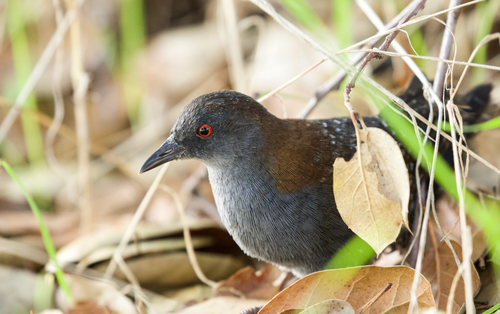
Black Rail
The Black Rail (*Laterallus jamaicensis*) is a small, elusive marsh bird known for its secretive nature and distinctive calls. It plays a crucial role in wetland ecosystems, primarily as a consumer of small invertebrates and seeds. This bird is rarely seen, preferring to stay hidden within dense vegetation, making it a subject of fascination and concern for bird enthusiasts and conservationists alike. Its declining populations across much of its range highlight the importance of protecting its fragile habitat.
12-15 cm
Length
20-28 cm
Wingspan
Near Threatened
Conservation Status
Distribution
The Black Rail has a fragmented distribution, found along the Atlantic and Gulf Coasts of the United States, parts of California, and scattered inland locations. It also occurs in Central America and the Caribbean. Migratory patterns vary; some populations are resident, while others undertake short-distance migrations.
Lifespan
Unknown for wild, but likely 1-3 years, given high mortality rates of small birds.
Black Rail's Habitat
Habitat Types
Salt marshes, Brackish marshes, Freshwater marshes, Wet meadows
Climate Zones
Temperate, Subtropical, Tropical
Adaptations
Their small size and laterally compressed bodies allow them to move easily through dense marsh vegetation. Their cryptic coloration provides camouflage within their preferred habitat.
Variations
Several subspecies are recognized, differing slightly in size and plumage. For instance, *Laterallus jamaicensis coturniculus* is found in California, and *Laterallus jamaicensis jamaicensis* is found along the Atlantic coast.
Appearance
Breeding Plumage
Adults have a dark, slate-gray body with a black face and throat. The back and wings are speckled with white. Juveniles are buffier and less distinctly marked.
Seasonal Feather Changes
Minimal seasonal variation.
Sex Based Plumage Differences
Males and females are visually similar.
Notable Features
Red eyes, Short, black bill, Dark legs and feet
Diet and Feeding
Primary Foods
Small invertebrates, Insects, Spiders, Snails, Seeds
Foraging Behavior
Black Rails forage by walking or running through dense vegetation, probing the ground and shallow water with their bills. They are most active at dawn and dusk, and sometimes at night.
Specializations
Their bill shape is suited for picking small prey items from mud and vegetation.
Seasonal Diet Variations
Diet may shift slightly depending on the availability of prey, with a greater reliance on seeds during the non-breeding season when invertebrates are less abundant.
Behavior
Social Structure
Generally solitary or found in pairs during the breeding season. They are not known to form flocks.
Communication
A distinctive "ki-ki-doo" call, often heard at night., Soft grunts and clicks used for close-range communication.
Migration
Some populations are resident, while others, particularly those in northern areas, migrate short distances to areas with milder winters and unfrozen ground.
Territorial or Group Behaviors
Black Rails are highly territorial during the breeding season, defending their nesting areas from other rails.
Conservation
Threats
Habitat loss and degradation (due to coastal development, agriculture, and water management), Sea level rise (due to climate change), Invasive species (e.g., feral cats, rats), Pesticide use
Protection Programs
Habitat restoration and management projects, Monitoring programs to track population trends, Research on the species' ecology and conservation needs
Local National Laws
Protected under the U.S. Migratory Bird Treaty Act. Listed as endangered, threatened, or a species of special concern in several states.
Population Trend
Decreasing
Population Estimates
Difficult to estimate due to the species' secretive nature; likely fewer than 10,000 mature individuals globally.
Interesting Facts
They are rarely seen flying.
Black Rails prefer to run or walk through dense vegetation, making them extremely difficult to observe.
They are one of the smallest rail species in North America.
Their small size allows them to navigate the dense marsh habitats they prefer.
They can swim and dive if necessary.
Although not their preferred method of locomotion, they are capable swimmers.
Faqs about Black Rail
Why are Black Rails so hard to see?
They are small, cryptically colored, and inhabit dense marsh vegetation. They are also most active at dawn and dusk, and even at night.
What is the biggest threat to Black Rails?
Habitat loss and degradation, primarily due to coastal development, agriculture, and changes in water management practices, pose the greatest threat.
Are Black Rails endangered?
The IUCN lists them as Near Threatened, and they are considered endangered, threatened, or of special concern in several U.S. states. Their populations are declining across much of their range.
Copyright @ Nature Style Limited. All Rights Reserved.
 English
English